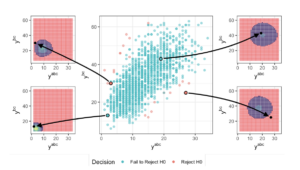Statistically significant

For each pair of qABC and qBC event counts, denoted yabc and ybc, seen during an orbit of the IBEX-Hi satellite, Kelly Moran and colleagues tested a hypothesis: that some shared underlying signal rate could plausibly have generated both counts. The center plot shows hypothesis test results for each observation. The four highlighted observations point to subplots showing the regions in which the hypothesis would be rejected (pink) and where the count pair actually fell (black points) in the subplots, indicating whether they were consistent with the hypothesis. This let the researchers assess whether and how heliospheric scientists can use both qABC and qBC data in their analyses. (Image: Kelly Moran.)
Applied statistician Kelly Moran spans disciplines at Los Alamos National Laboratory (LANL) like a journeyman carpenter, dipping into her mathematical toolbox to help researchers make discoveries.
“We want to make sure their data are what they need to answer that question and build models and systems to help them do the answering,” she says.
Moran joined LANL’s Statistical Sciences Group in the Computer, Computational and Statistical Sciences (CCS) division in 2020 after working at the lab occasionally over five years. While a Clemson University undergraduate, she contacted a LANL epidemiology group about a paper it produced – and got a job there. Moran left after a year to pursue a Duke University statistics doctorate with a Department of Energy Computational Science Graduate Fellowship (DOE CSGF), leading to 2017 and 2018 practicums at Los Alamos and a 2019 summer job there.
Her early projects mostly focused on epidemiology, analyzing data, such as internet search traffic, to forecast global disease and medical trends, but Moran has expanded to other fields since joining LANL permanently.
“At Los Alamos, the opportunity to work on lots of different application areas is easy to come by,” she says. It’s often “saying yes or being in the room when someone happens to say they need a statistician.” More options “means more chances to cherry-pick what I want to work on.”
Moran’s latest research takes her to space. She analyzed data from the Interstellar Boundary Explorer (IBEX), a NASA satellite that collects data used to map the heliosphere, where the sun’s particles meet outer space. IBEX has three particle-detecting sensors – including one LANL technicians built – whose data can track interactions between the heliosphere and space. Those passing through all sensors are qABC (qualified ABC) events, “our gold standard observations,” Moran says. But qBC events, in which just two specific instruments detect particles, also interest astrophysicists and are more plentiful than qABC events.
Moran explored whether the same underlying heliosphere signal could produce both kinds of events. She generated the statistically most likely heliosphere signal based on the data and found that the two event types could plausibly share it.
Moran also helps probe cosmic structure, writing an emulator – a simpler surrogate for computationally demanding code – to predict the matter power spectrum for the Mira-Titan Universe simulation. This model was devised by an international team, led by Argonne National Laboratory researchers, and named for the two DOE supercomputers it ran on.
The matter power spectrum contrasts matter’s density – the degree to which it clumps – between relatively small, local scales and a universe-wide scope. Large-scale structures grow linearly; theory is sufficient to describe them. Smaller-scale structures develop more randomly, requiring demanding simulations.
Moran based the emulator on data from 111 high-resolution simulation runs. The model spans multiple scales and lets researchers tweak parameters, such as dark-matter behavior, to grasp their influence on cosmic structure. She used statistical modeling to learn the relationship between these parameters and the resulting matter power spectrum so that supercomputers can make predictions at new parameter settings in seconds instead of weeks.
In 2021, Moran studied the spread of viral variants during the COVID-19 pandemic. With statistician Lauren Beesley and other colleagues, she analyzed data to understand what influences the speed with which mutant strains, such as delta and omicron, become dominant. “We were looking at how those takeovers happened across different locations, both national-level and some subnational-levels” to track the role of demographics, such as age and vaccination rates.
The researchers found a country’s strong natural immunity, following recent COVID-19 infection peaks, was associated with a later transition to a new variant compared to other countries. Higher vaccination rates often led to slower transitions to variants, but not always: omicron resisted vaccine-produced antibodies.
Moran has used her coding skills to help automate the LANL Occupational Safety and Health Division’s system to test and monitor employee health and hazard exposure. She’s also on a CCS panel that fosters social, professional and funding opportunities for early-career and new LANL workers.
About the Author
The author is a former Krell Institute science writer.






You must be logged in to post a comment.